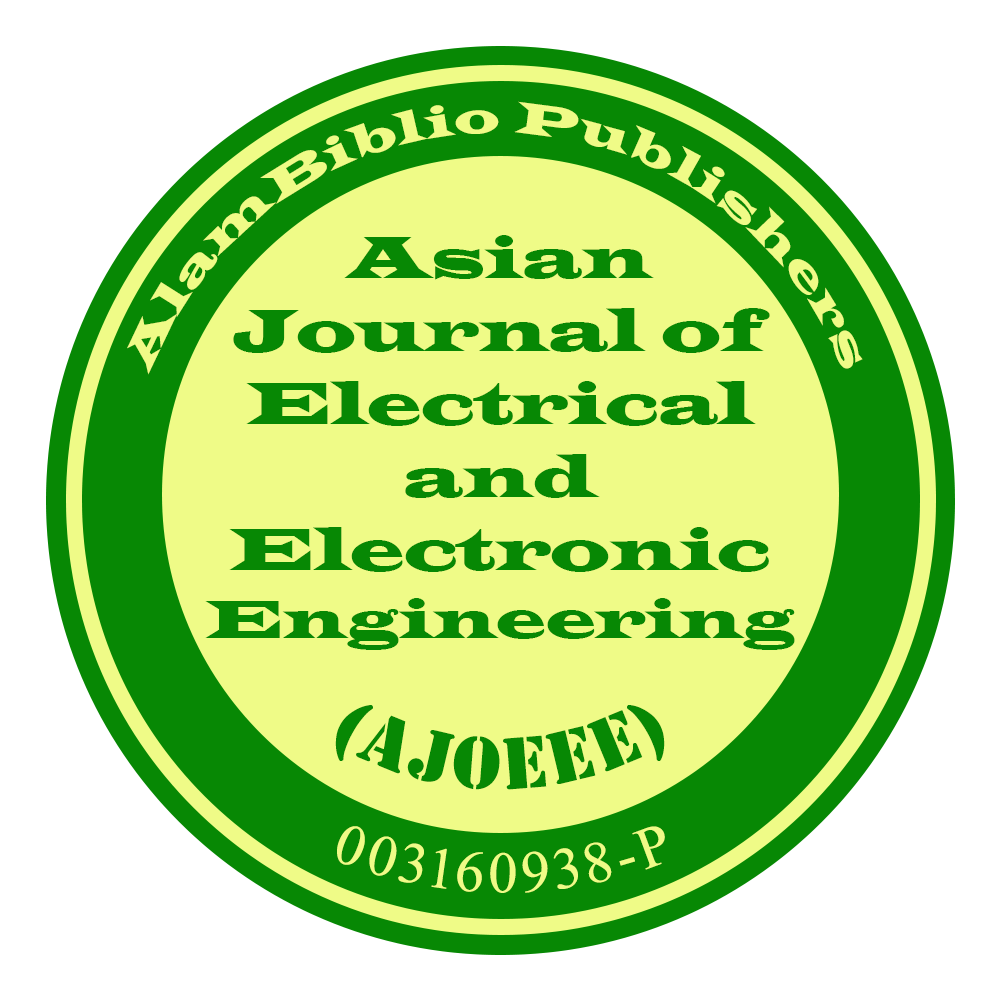A New Topology of High-Efficiency DC-DC Hybrid Boost SEPIC Converter for PV Cell
DOI:
https://doi.org/10.69955/ajoeee.2022.v2i2.33Keywords:
Step-up Converter, High voltage gain, SMPS, MOSFET SwitchAbstract
This paper initiates a high-gain high efficiency step-up DC-DC converter based on Boost SEPIC (Single Ended Primary Inductor Converter) hybrid topology for photovoltaic application. Customarily DC-DC converter circuit is a widely used technique to improve the voltage level of solar cells. However, for low output voltage and low efficiency, they are not sufficient enough to provide expected outcomes. To defeat the conventional system a hybrid Boost SEPIC topology has been recommended with enhanced performance. The proposed design of the DC-DC converter circuit can provide a high voltage gain without decaying its overall performance. The modified converter topology is being worked by a single switch with low switching voltage stress over the semiconductor devices. The main edge of the proposed design is that it can perform efficiently without using any transformer, the combined design of Boost SEPIC topology increases the voltage gain much higher compared to the conventional Boost or SEPIC. The maximum Power Point Tracking (MPPT) algorithm is used to obtain maximum power from a photovoltaic source. MATLAB Simulink and PSIM software has analyzed the performance of the newly designed converter circuit thoroughly.
Downloads
References
S. Ali et al., “Evaluating green technology strategies for the sustainable development of solar power projects: Evidence from Pakistan,” Sustain., vol. 13, no. 23, pp. 1–29, 2021, https://doi.org/10.3390/su132312997 DOI: https://doi.org/10.3390/su132312997
F. Mumtaz, N. Zaihar Yahaya, S. Tanzim Meraj, B. Singh, R. Kannan, and O. Ibrahim, “Review on non-isolated DC-DC converters and their control techniques for renewable energy applications,” Ain Shams Eng. J., vol. 12, no. 4, pp. 3747–3763, 2021, https://doi.org/10.1016/j.asej.2021.03.022 DOI: https://doi.org/10.1016/j.asej.2021.03.022
A. Torkan and M. Ehsani, “A Novel Nonisolated Z-Source DC-DC Converter for Photovoltaic Applications,” IEEE Trans. Ind. Appl., vol. 54, no. 5, pp. 4574–4583, 2018, https://doi.org/10.1109/TIA.2018.2833821 DOI: https://doi.org/10.1109/TIA.2018.2833821
S. Salehi, N. Zahedi, R. Kheirollahi, and E. Babaei, “Ultra High Step-up DC-DC Converter Based on Switched Inductor-Capacitor Cells,” 2019 10th Int. Power Electron. Drive Syst. Technol. Conf. PEDSTC 2019, pp. 367–372, 2019, https://doi.org/10.1109/PEDSTC.2019.8697841 DOI: https://doi.org/10.1109/PEDSTC.2019.8697841
S. Poshtkouhi and O. Trescases, “Multi-input single-inductor DC-DC converter for MPPT in parallel-connected photovoltaic applications,” Conf. Proc. - IEEE Appl. Power Electron. Conf. Expo. - APEC, vol. 4, pp. 41–47, 2011, https://doi.org/10.1109/APEC.2011.5744573 DOI: https://doi.org/10.1109/APEC.2011.5744573
K. Kanathipan, M. A. M. Cheema, and J. Lam, “Five-Level Inverter With A Combined DC Voltage Balancing and Fault-voltage Mitigation Technique for Grid-Connected PV Energy Systems,” 2021 IEEE PES Innov. Smart Grid Technol. - Asia, ISGT Asia 2021, 2021, https://doi.org/10.1109/ISGTAsia49270.2021.9715629 DOI: https://doi.org/10.1109/ISGTAsia49270.2021.9715629
E. Ragonese, N. Spina, A. Parisi, and G. Palmisano, “An experimental comparison of galvanically isolated dc-dc converters: Isolation technology and integration approach,” Electron., vol. 10,no. 10, 2021, https://doi.org/10.3390/electronics10101186 DOI: https://doi.org/10.3390/electronics10101186
O. Kircioǧlu, M. Ünlü, and S. Çamur, “Modeling and analysis of DC-DC SEPIC converter with coupled inductors,” 2016 Int. Symp. Ind. Electron. INDEL 2016 - Proc., 2016, https://doi.org/10.1109/INDEL.2016.7797807 DOI: https://doi.org/10.1109/INDEL.2016.7797807
C. Muranda, E. Ozsoy, S. Padmanaban, M. S. Bhaskar, V. Fedák, and V. K. Ramachandaramurthy, “Modified SEPIC DC-to-DC boost converter with high output-gain configuration for renewable applications,” 2017 IEEE Conf. Energy Conversion, CENCON 2017, vol. 2018-January, pp. 317–322, 2017, https://doi.org/10.1109/CENCON.2017.8262505 DOI: https://doi.org/10.1109/CENCON.2017.8262505
K. S. Kavin and P. Subha Karuvelam, “PV-based Grid Interactive PMBLDC Electric Vehicle with High Gain Interleaved DC-DC SEPIC Converter,” IETE J. Res., 2021, https://doi.org/10.1080/03772063.2021.1958070 DOI: https://doi.org/10.1080/03772063.2021.1958070
A. Mahmood et al., “A Non-Inverting High Gain DC-DC Converter with Continuous Input Current,” IEEE Access, vol. 9, pp. 54710–54721, 2021, https://doi.org/10.1109/ACCESS.2021.3070554 DOI: https://doi.org/10.1109/ACCESS.2021.3070554
R. Rahimi, S. Habibi, P. Shamsi, and M. Ferdowsi, “A Dual-Switch Coupled Inductor-Based High Step-Up DC-DC Converter for Photovoltaic-Based Renewable Energy Applications,” pp. 1–6, 2021 DOI: https://doi.org/10.1109/TPEC51183.2021.9384916
L. Yang, J. Peng, F. Yang, Y. Zhang, and H. Wu, “Single-Phase High-gain Bidirectional DC/AC Converter Based on High Step-up/step-down DC/DC Converter and Dual-input DC/AC Converter,” PEDG 2019 - 2019 IEEE 10th Int. Symp. Power Electron. Distrib. Gener. Syst., pp. 554–559, 2019, https://doi.org/10.1109/PEDG.2019.8807762 DOI: https://doi.org/10.1109/PEDG.2019.8807762
Downloads
Published
Issue
Section
License
Copyright (c) 2022 AlamBiblilo Publishers

This work is licensed under a Creative Commons Attribution-NonCommercial 4.0 International License.
The Asian Journal of Electrical and Electronic Engineering journal is licensed under a Creative Commons Attribution-NonCommercial 4.0 International License.










